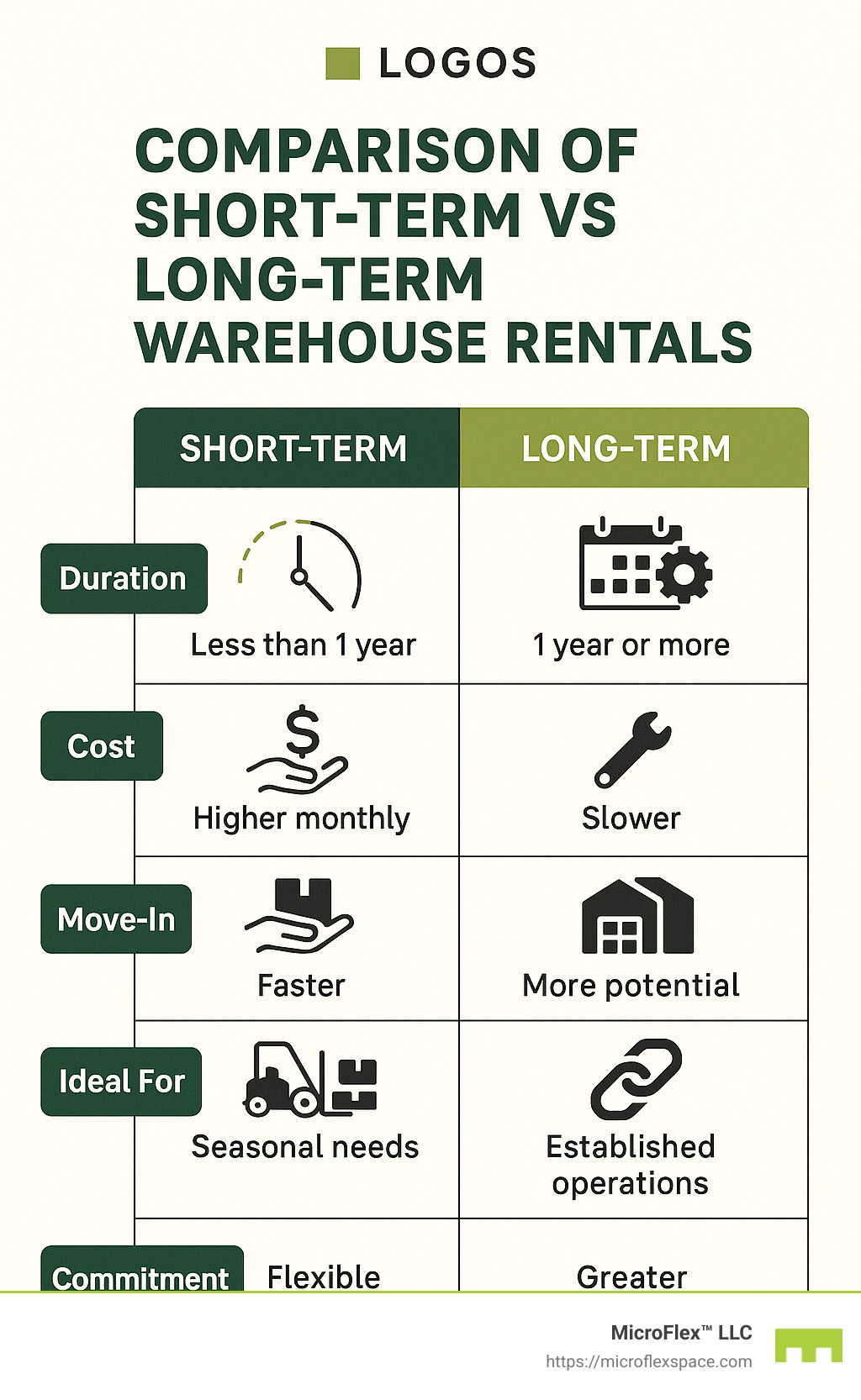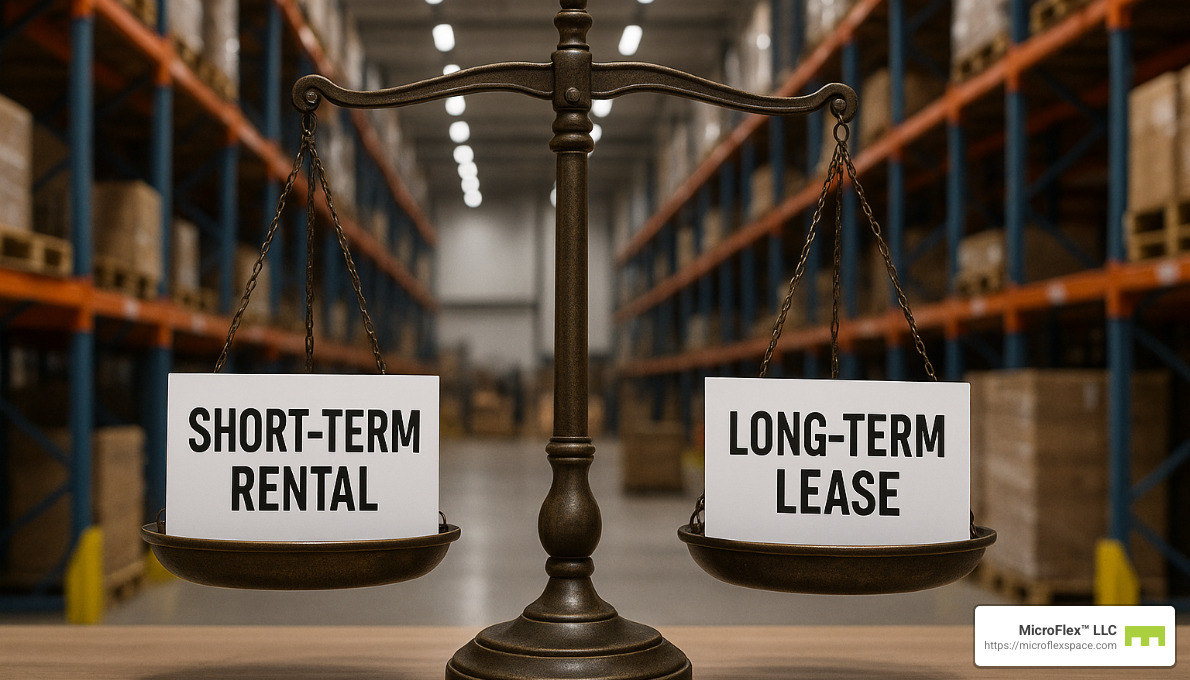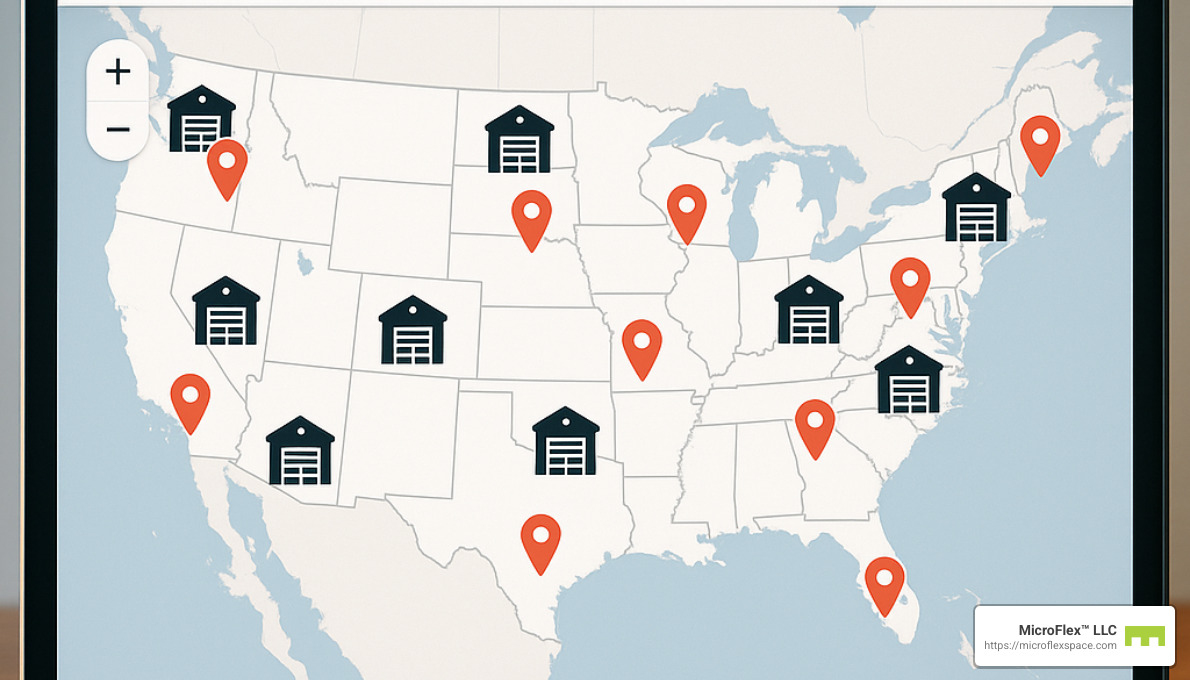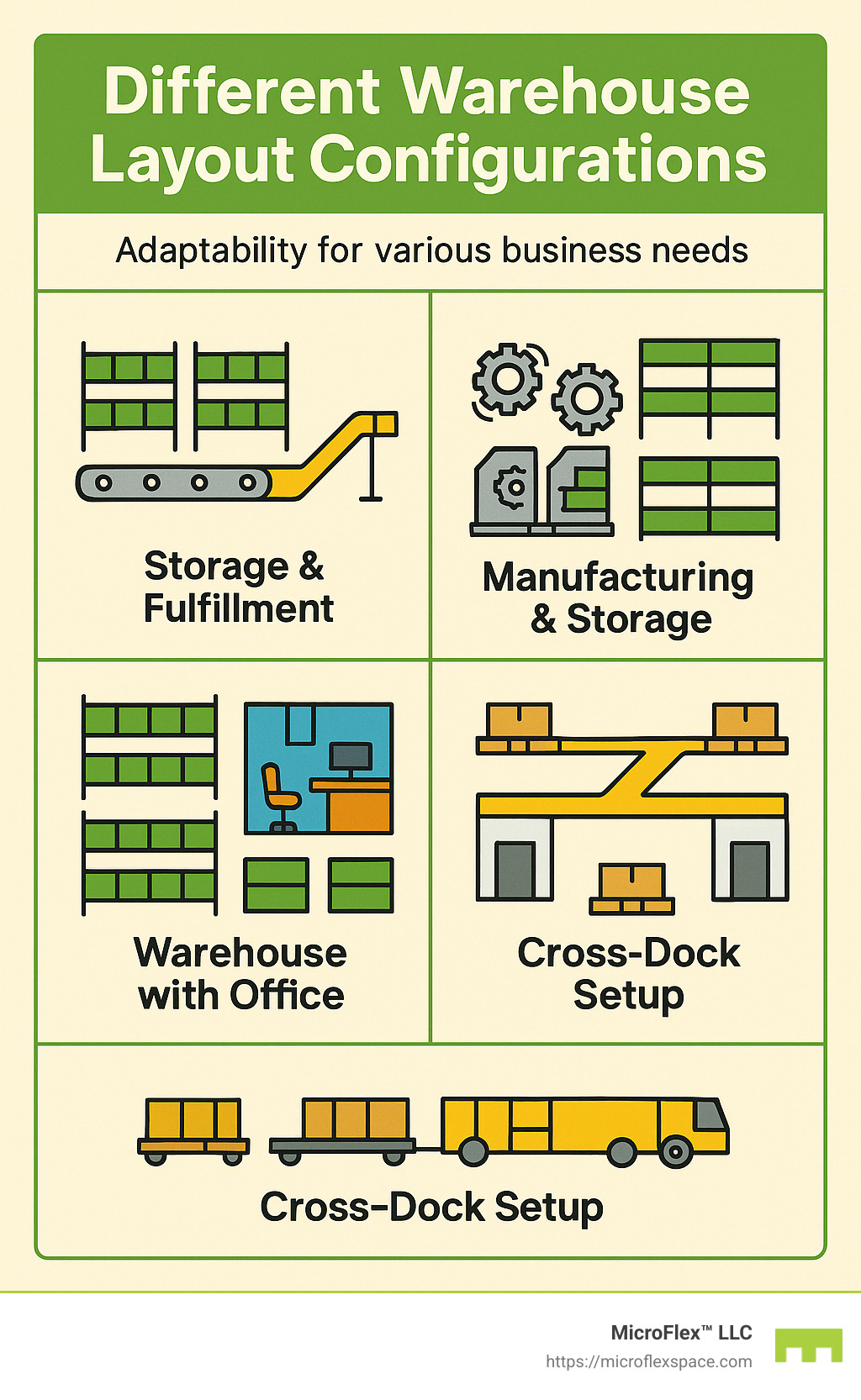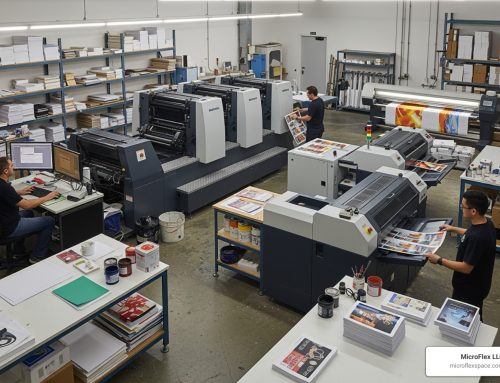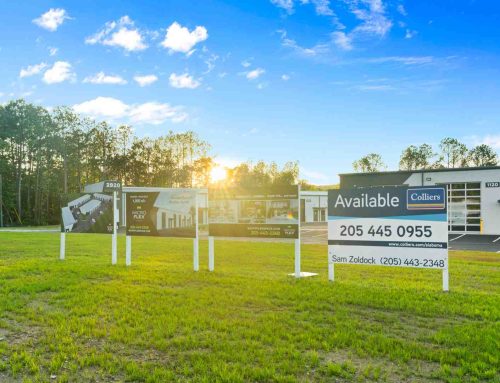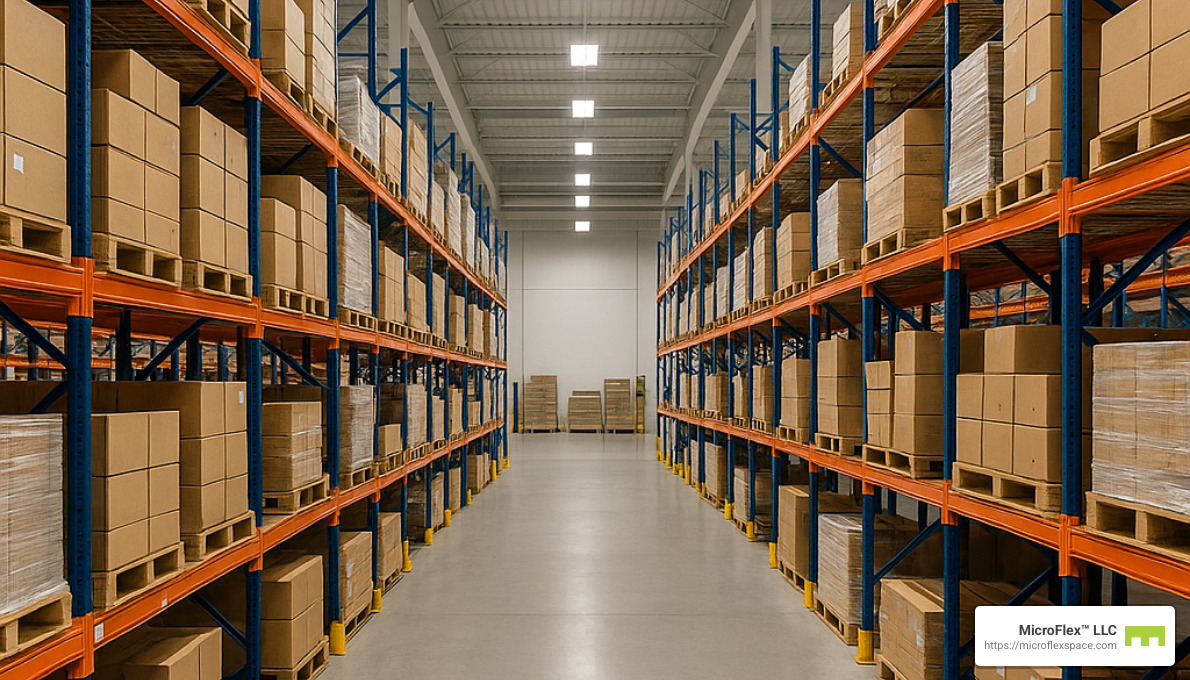
Finding the Right Warehouse Solution for Your Business
Let’s face it – your business storage needs can change as quickly as Alabama weather. That’s where short-term warehouse rental comes in, offering breathing room when you need it most.
Think of short-term rentals as the friendly neighbor who loans you their garage space – just more professional and without the awkward holiday card exchanges. These flexible arrangements typically span from one month to a year, perfect for when life throws your business a curveball.
Wondering how short-term stacks up against traditional leasing? Here’s the quick comparison:
| Short-Term Warehouse Rental | Long-Term Warehouse Leasing |
|---|---|
| Duration: 1-12 months | Duration: 5-10 years |
| Higher monthly rate | Lower monthly rate |
| Minimal upfront costs | Substantial upfront costs |
| Flexible terms | Limited flexibility |
| Ideal for: seasonal needs, market testing, startups | Ideal for: established operations, stable inventory needs |
| Move-in as fast as 24-48 hours | Move-in often takes weeks/months |
| Limited customization | Extensive customization possible |
I’ve seen countless small business owners breathe sighs of relief when finding they don’t need to sign their lives away for decent warehouse space. The sharing economy has worked its magic on warehousing just as it has with ride-sharing and vacation rentals – creating opportunities to access premium storage without premium commitment.
Short-term warehouse rental shines brightest when your business faces seasonal rushes (hello, holiday inventory!), needs breathing room during a location change, or wants to dip a toe into a new market. One industry expert put it perfectly: “The sharing economy is fast becoming a way of the future with keywords such as ‘flexible’ and ‘agile’ becoming a market norm in the logistics supply chain environment.”
Beyond just avoiding lengthy contracts, these rentals often come with unexpected perks – loading docks, pallet jacks, WiFi connectivity, and sometimes even attached office space. It’s like getting the VIP package without joining the lifetime membership club.
Here at MicroFlex™ LLC, we’ve seen how the right temporary space can make all the difference between stressful growth and smooth scaling. Whether you’re launching an exciting new product line, managing the holiday rush, or temporarily expanding while you find your forever home, finding the perfect warehouse solution shouldn’t keep you up at night.
Understanding Short-Term Warehouse Rental vs. Long-Term Leasing
When you’re searching for warehouse space, understanding the difference between renting short-term and leasing long-term can save you thousands of dollars and countless headaches. These options aren’t just different in duration—they represent entirely different approaches to managing your business space needs.
Defining Lease Durations
Think of short-term warehouse rental as the “try before you buy” option of commercial real estate. These arrangements typically span from one month to one year, giving you breathing room to figure out your next move.
The flexibility is what makes short-term rentals so appealing. Very short-term options of 1-3 months are perfect when you need extra space for those holiday rushes. Standard short-term rentals running 3-6 months give you enough time to test a new market without a major commitment. And extended short-term options of 6-12 months provide a sweet spot for businesses in transition.
The best part? Many short-term warehouse rental agreements offer month-to-month extensions after the initial period. This means you can stay exactly as long as you need—no more, no less.
Long-term leases, on the other hand, are more like a marriage—complete with a 5-10 year commitment and a thick contract spelling out everyone’s responsibilities. These typically come with annual rent increases, renewal options, and more substantial tenant improvement allowances. The trade-off? You’re on the hook for most maintenance and repairs.
As one of our warehouse partners recently told me, “Long-term leases work beautifully for businesses that can predict their future with confidence. For everyone else, there’s short-term rental.”
Typical Use Cases
Short-term warehouse rental shines in situations where flexibility is worth its weight in gold.
Seasonal demand spikes drive many of our customers to short-term solutions. That Halloween costume company that needs extra space from July through October? They’d be paying for empty space the other eight months of the year with a traditional lease.
Market testing is another perfect scenario. Why commit to a five-year lease in a new city when you can test the waters first? With a short-term warehouse rental, you can gather real data about your operation’s success in a new market before making a long-term commitment.
Special projects often require temporary space solutions. One of the most creative examples I’ve seen involved a theater company that transformed three connected warehouses into an immersive Shakespeare experience. The production was stunning—and when it ended, they weren’t stuck with years of lease payments.
Disaster recovery situations demand quick solutions. Tracey Scott, a Regional Manager who faced this challenge firsthand, shared with us: “After the EF 5 tornado, our business was completely destroyed. We knew we had to act quickly. Working with [a temporary structure provider], there was a fantastic level of expediency. The temporary structure turned out to be a terrific solution.”
Startups and new ventures benefit enormously from lower commitment levels while they’re still figuring out their operational patterns. Why lock yourself into a space that might be too small (or too large) a year from now?
At MicroFlex™ LLC, we’ve watched businesses use our spaces in Birmingham, Huntsville, and Auburn-Opelika for everything from e-commerce fulfillment to creative studios and pop-up showrooms. The common thread? They all needed flexibility that traditional leasing simply couldn’t provide.
When your business needs room to breathe and grow on its own timeline, short-term warehouse rental offers the perfect balance of professional space without the professional headache of long-term commitments.
Pros, Cons, Costs & Risk Management
When you’re weighing your warehouse options, understanding what you’re getting into financially and practically makes all the difference. Let’s break down what you can expect with each approach.
Short-Term Warehouse Rental: Key Benefits
The beauty of short-term warehouse rental lies in its flexibility. Think of it as dating before marriage – you get to test the waters without signing away years of your life.
The most obvious advantage is the low commitment and risk. In today’s unpredictable business landscape, being able to pivot quickly can mean the difference between thriving and merely surviving. You’re not tied down during uncertain times or when testing new markets.
Need space yesterday? Rapid access is another major perk. While traditional leases often move at a glacial pace, short-term spaces can sometimes be yours within 24-48 hours. As one satisfied business owner told us: “The approval process was simple and easy. I’ve been fortunate to grow my business and move into a larger space all with the help of my short-term provider.”
With pay-per-use efficiency, you’re only paying for space when you actually need it – perfect for seasonal businesses. Why pay for empty space during your slow months?
Many short-term facilities come with valuable included amenities already in place – loading docks, security systems, office space, WiFi, and sometimes even equipment like forklifts. It’s like moving into a furnished apartment instead of an empty one.
The operational flexibility to scale up or down quickly gives you a strategic edge, while minimal upfront costs mean you’re not depleting your capital reserves just to secure the space.
Of course, there’s no free lunch. These conveniences come with trade-offs: higher monthly rates, limited customization options, the potential hassle of multiple moves if your needs extend beyond the initial term, and less predictable availability in competitive markets.
Budgeting & Hidden Fees
When budgeting for a short-term warehouse rental, the sticker price is rarely the whole story. It’s like buying a car – you need to consider the total cost of ownership, not just the monthly payment.
Watch out for those NNN (Triple Net) charges that can sneak up on you. These pass-through costs for property taxes, building insurance, and common area maintenance can add $4 per square foot annually or more to your expenses.
Utilities may or may not be included in your base rent. If they’re not, you’ll need to factor in electricity (especially important if you have equipment or climate control needs), water, and internet service.
Most landlords will require a security deposit (typically equal to one month’s rent) and specific insurance requirements including general liability coverage (usually $1-2 million) and property insurance for your inventory and equipment.
Be aware of potential service fees from rental platforms or brokers, and expect to pay a short-term premium of 15-30% more per month compared to long-term rates. That’s the price of freedom!
At MicroFlex™ LLC, we believe life’s complicated enough without surprise charges. That’s why our rates are all-inclusive, covering most extras so you can budget with confidence.
Mitigating Risk
Even Shakespeare got into the warehouse game – did you know a production company once transformed three warehouses into an immersive performance of Macbeth? The innovative Sleep No More) production shows just how versatile warehouse spaces can be. But for your business, you’ll want a more cautious approach.
Proper insurance coverage is non-negotiable regardless of your lease duration. Verify exactly what’s required and whether your existing business policies have you covered.
Take a hard look at security considerations before signing anything. Does the facility offer 24/7 surveillance, access control, on-site management, and solid perimeter security? Your inventory deserves protection.
Always have clear exit strategies in mind. Understand notice requirements, early termination fees, and extension possibilities before you commit. Even short-term relationships need boundaries!
Develop contingency plans for scenarios where your space becomes unavailable for renewal, your needs change unexpectedly, or the facility experiences problems like flooding or power outages.
Finally, have a legal professional review your contract before signing. As one seasoned warehouse tenant advises: “Always ask if there is NNN and what that is along with any OPEX. If you’re not physically running your business from the space, you’ll end up paying for a bunch of things you don’t need.”
By understanding these considerations, you’ll be better equipped to choose between a short-term warehouse rental and a long-term lease based on what makes the most sense for your unique business situation and risk tolerance.
Securing the Perfect Space: Search, Negotiation, Move-In & Scalability
Finding the right warehouse space is a bit like dating – you need to know where to look, ask the right questions, and make sure it’s a good fit before committing. Even with short-term warehouse rental, a strategic approach can save you headaches and money.
Where to Find Short-Term Warehouse Rental Listings
The market for flexible warehouse space has exploded in recent years, giving businesses more options than ever before.
Digital platforms have revolutionized the search process, with several sites now functioning essentially as an “Airbnb for warehouses.” These marketplaces let you filter by location, size, and amenities, with transparent pricing and user reviews to guide your decision. The convenience of handling everything from booking to payment online has made these platforms increasingly popular.
Commercial real estate brokers can be valuable allies in your search, despite their traditional focus on long-term leases. They often have access to properties that never make it to public listings and can leverage their relationships to get you better terms. Best of all, the landlord typically covers their fee, not you. As one industry insider candidly puts it, “Many brokers ignore small-space clients until the market softens,” so be clear about your needs and budget from the start.
Don’t overlook direct connections with property owners. A drive through local industrial areas can reveal vacancy signs, and networking with local business associations might uncover opportunities before they hit the market. Sometimes the best deals come from businesses with excess space looking to offset their costs through subleases – these can offer great value and facilities already set up for similar operations.
The growing trend of co-warehousing provides another flexible option. Similar to co-working spaces but for warehouse needs, these facilities offer the bonus of a built-in community of like-minded businesses alongside shared amenities like loading docks and office space.
At MicroFlex™ LLC, we’re proud to offer various short-term warehouse rental options across our Alabama locations in Birmingham-Irondale, Birmingham-Hoover, Huntsville, and Auburn-Opelika. Our transparent terms and all-inclusive pricing eliminate the guesswork that often comes with warehouse hunting.
Negotiating Like a Pro
Even with shorter commitments, there’s usually room to negotiate better terms. The key is knowing what to ask for.
Start by doing your homework on local market rates. Knowledge is power, and understanding the going rate for similar spaces gives you a strong foundation for negotiations. When discussing terms, always clarify all potential costs upfront. Ask specifically about base rent, but don’t forget to inquire about those pesky NNN charges, CAM fees, utilities, and any other expenses that might surprise you later.
Flexibility clauses can be your best friend in a short-term warehouse rental agreement. Consider negotiating extension options at predetermined rates, early termination provisions in case your plans change, and rights to adjacent spaces if you anticipate growth. One often overlooked area is insurance requirements – sometimes these can be adjusted based on your actual usage. As one savvy renter shared, “The manager confirmed only general liability is required,” after initially being presented with a much longer list of insurance demands.
Move-in timing can affect your bottom line too. Some landlords will prorate the first month if you’re not using the full period, so it never hurts to ask. And if you’re renting during slower seasons, you might have more leverage to negotiate better rates or included services like cleaning, maintenance, or equipment access.
The worst they can say is no – and you’d be surprised how often the answer is yes when you simply ask for better terms.
Scaling Up or Down Fast
The beauty of short-term warehouse rental is the ability to adapt quickly as your business evolves. This flexibility is especially valuable in today’s unpredictable business climate.
Many modern warehouse facilities feature modular bay systems designed with scalability in mind. These standardized spaces (often in 5-meter increments) can be combined or separated as needed, allowing you to adjust your footprint without completely relocating. The shared loading areas that serve multiple units mean you maintain logistics efficiency even as you resize your space.
For rapid expansion needs, temporary structures offer surprising versatility. Despite their name, these buildings can last 20+ years while costing 70% less than permanent construction. With installation possible in as little as 3-5 days and impressive dimensions (heights up to 10 meters and spans up to 40 meters), they provide quick solutions to sudden space challenges. As one provider notes, “Fast installation takes just days, with a mid-size build completed in three to five days without disrupting operations.”
Co-warehousing spaces excel at accommodating growth, allowing you to rent multiple adjacent units as needed or access shared overflow space during peak periods. The ability to expand without changing your address or systems provides valuable operational continuity.
The stark reality of outgrowing your space was captured perfectly by one e-commerce business owner: “I have outgrown my storage units. Using them for inventory has become a complete nightmare.” By switching to a flexible warehouse solution, they went from paying $925/month for inadequate storage units to $1,200/month for a proper 1,200 sq ft warehouse with loading dock access – a game-changer for their operation.
At MicroFlex™ LLC, our Birmingham-Hoover location showcases our commitment to scalability, with various unit sizes designed to grow alongside your business. Check out more information about Birmingham-Hoover spaces to see how our combination of warehouse, office, and showroom functions allows you to adapt without the disruption of relocation.
When your business is evolving rapidly, the ability to scale your space up or down with minimal friction isn’t just convenient – it’s a competitive advantage.
Frequently Asked Questions about Short-Term Warehouse Rental
How long can I rent a warehouse short-term?
When businesses ask about short-term warehouse rental durations, I always tell them it’s more flexible than they might think. Typically, you’re looking at anywhere from one month to a year, with plenty of options in between.
Most of our clients at MicroFlex™ LLC start with a modest commitment—often just a few months—then extend as they get comfortable. It’s a bit like dating before marriage! Some providers do require a minimum stay (usually 1-3 months), but after that initial period, you’ll frequently find month-to-month options that let you adjust as you go.
I’ve seen seasonal businesses thrive with 3-4 month rentals during their busiest times, then scale back during slower periods. One Halloween retailer told me, “Having space just when we need it saved us from paying for empty warehouse space for eight months of the year!”
Do I need special insurance?
Yes, you’ll need insurance for your short-term warehouse rental, but don’t let that intimidate you! Most of our tenants find their existing business policies cover much of what’s needed, with perhaps a few adjustments.
Typically, you’ll need general liability insurance (usually $1-2 million in coverage) to protect against third-party claims if someone gets injured or property gets damaged. You’ll also want property insurance for your inventory and equipment—after all, protecting your business assets is just good sense!
Depending on your specific operations, you might need additional coverage. If you have employees working in the space, workers’ compensation is generally required. Using vehicles as part of your business? Auto liability might be on the checklist too.
One of our tenants at MicroFlex™ LLC recently finded they could simplify their coverage: “I was worried about needing a bunch of expensive policies, but after talking with the property manager, we figured out I only needed basic liability since I don’t have employees and don’t use company vehicles.” We pride ourselves on requiring only what’s truly necessary for your specific situation.
How quickly can I move in?
The speed of move-in is where short-term warehouse rental really shines compared to traditional leasing! While conventional leases might take weeks or months to finalize, short-term spaces often welcome you in a matter of days.
Many of our clients at MicroFlex™ LLC complete their paperwork one day and are moving in their inventory the next. One e-commerce business owner told me, “I signed the agreement on Tuesday and was fulfilling orders from my new space by Thursday afternoon. That kind of turnaround saved my business during our unexpected growth spurt.”
Several factors affect your timeline: insurance verification, paperwork processing, and your own moving logistics. Online marketplace platforms often advertise next-day access, while co-warehousing facilities typically get you in within 24-48 hours. Even temporary warehouse structures can be installed surprisingly quickly—sometimes in just 3-5 days for mid-sized buildings.
A manufacturing client once shared, “When our main facility flooded, we couldn’t afford downtime. Having a move-in ready space within days meant we barely missed a beat in production.”
What amenities should I expect?
Today’s short-term warehouse rental spaces are far more sophisticated than the bare-bones storage units of the past. Think of them more as operational hubs with all the conveniences you need to hit the ground running.
Loading facilities are the backbone of any good warehouse space. Look for loading docks with levelers for truck deliveries, grade-level doors for easier access, and adequate staging areas to organize shipments. One distributor told me, “Having a proper loading dock cut our unloading time in half compared to our previous makeshift solution.”
Many modern facilities include material handling equipment like forklifts and pallet jacks—a significant cost savings when you’re just starting out or temporarily expanding. Office space is another valuable addition, giving you a professional environment for meetings and administrative work without renting separate facilities.
Technology infrastructure has become increasingly important, with WiFi, security systems, and climate controls often standard in better facilities. Some even include shared services like reception, mail handling, and maintenance.
At MicroFlex™ LLC, our spaces combine warehouse functionality with office amenities, creating versatile environments where you can manage both the operational and administrative sides of your business under one roof. One client who runs a specialty food business summed it up nicely: “Having both storage space and a small office means I can meet with potential retailers in a professional setting, then walk them right over to see our production area. It’s made a huge difference in closing deals.”
Can I customize the space?
When it comes to customizing your short-term warehouse rental, think of it like a furnished apartment rather than building your own house. You’ll have options, but they’ll vary based on your lease duration and the facility’s policies.
For very brief rentals (1-3 months), expect to make only temporary, non-structural changes. As your commitment lengthens to 3-6 months or beyond, more substantial modifications often become possible with landlord approval.
Common customizations include installing racking and shelving (essential for efficient inventory management), adjusting lighting for your specific operations, setting up your network and technology systems, and sometimes adding temporary climate control for sensitive products.
One craft brewery using our space temporarily while building their permanent location told me, “Being able to install our specific racking system and temperature monitors meant we could maintain our quality standards even in a temporary space.”
If you’re planning modifications, remember these golden rules: get everything in writing before signing, use licensed contractors when required, and understand whether you’ll need to return the space to its original condition when you leave.
At MicroFlex™ LLC, we designed our spaces with adaptability in mind. Many walls are non-load-bearing, lighting is adjustable, and our power systems accommodate various equipment needs. This built-in flexibility means most businesses can configure the space to their needs without major construction work.
Conclusion
Choosing between a short-term warehouse rental and a long-term lease ultimately depends on your specific business needs, growth projections, and risk tolerance. The warehouse rental landscape has evolved dramatically in recent years, creating more options than ever for businesses of all sizes.
Short-term rentals offer best flexibility and minimal commitment, making them ideal for:
- Seasonal operations
- Market testing
- Project-based needs
- Businesses in transition
- Startups and growing companies
As one business owner who successfully used short-term space shares: “WareSpace allowed me to procure my first business rental property, without the usual overhead costs such as HVAC, electrical, plumbing, etc. The approval process was simple and easy. I have been fortunate to grow my business and move into a larger space all with the help of [the provider].”
While the per-square-foot cost may be higher than long-term leases, the reduced financial commitment and included amenities often make short-term options more economical overall, especially when considering the hidden costs and inflexibility of traditional leases.
At MicroFlex™ LLC, we’ve designed our warehouse solutions with this modern business reality in mind. Our multi-function spaces across Alabama—in Birmingham-Irondale, Birmingham-Hoover, Huntsville, and Auburn-Opelika—combine warehouse, office, storage, and showroom features under one roof, with flexible lease terms that grow with your business.
Remember these key takeaways when considering your warehouse options:
- Clearly define your needs: Duration, space requirements, location, and essential features
- Understand all costs: Look beyond the base rent to total occupancy cost
- Negotiate intelligently: Even short-term leases have room for discussion
- Plan for change: Consider how your space needs might evolve
- Read the fine print: Understand insurance requirements, exit clauses, and renewal options
By taking a strategic approach to your warehouse decisions, you can secure space that supports your business objectives while maintaining the flexibility to adapt to changing market conditions.
Whether you’re looking for a temporary solution or testing the waters before a longer commitment, short-term warehouse rental options provide the agility that modern businesses need to thrive in today’s dynamic economy.
For more information about MicroFlex™ LLC’s adaptable spaces across Alabama, visit our locations page or contact us to discuss your specific warehouse needs.


